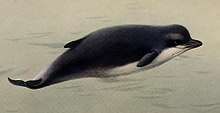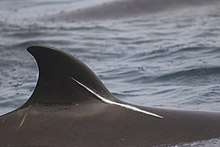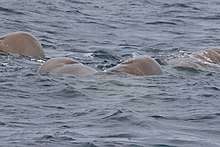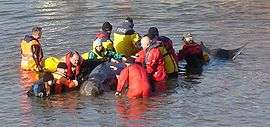Northern bottlenose whale
| Northern bottlenose whale | |
|---|---|
 | |
 | |
| Size compared to an average human | |
| Scientific classification | |
| Kingdom: | Animalia |
| Phylum: | Chordata |
| Class: | Mammalia |
| Order: | Artiodactyla |
| Infraorder: | Cetacea |
| Family: | Ziphiidae |
| Genus: | Hyperoodon |
| Species: | H. ampullatus |
| Binomial name | |
| Hyperoodon ampullatus (Forster, 1770) | |
| Northern bottlenose whale range | |
The northern bottlenose whale (Hyperoodon ampullatus) is a species of beaked whale in the ziphiid family, being one of two members of the genus Hyperoodon. The northern bottlenose was hunted heavily by Norway and Britain in the 19th and early 20th centuries. It is one of the deepest-diving mammals known, reaching depths of 1,453 m (4,767 ft).[2][3]
Description

When physically mature, northern bottlenose whales can reach 9.8 metres (32 ft) in length,[4] smaller than Giant Beaked Whales, and larger than known records of southern bottlenose whales. Their foreheads, or melons are sexually dimorphic, so that mature males have larger melons, which are flattened or square shape, while mature females and juveniles have rounder melons.[5] Melon coloration can vary, though it appears the head of most males becomes more white or buff colored with age. The beak is not as long as other beaked whale species, and only mature males have two small teeth, which erupt at the front end of the bottom jaw, but are not easily seen.[5] Females also have teeth, but they are buried in the jaw and do not erupt. The dorsal fin is relatively small, at 30–38 centimetres (12–15 in) and about 2/3 of the way back on their bodies. It is falcate (sickle-shaped) and usually pointed. The back is mid-to-dark grey with a lighter underside. They weigh approximately 5,800–7,500 kilograms (12,790–16,530 lb).[6][7]
Behaviours

Unlike many species of beaked whale, northern bottlenose whales are known to approach and appear curious about vessels, which made them relatively easy targets for whale hunters. However they have demonstrated avoidance to certain sounds such as those emitted by naval sonar in controlled dose response studies.[8]
Underwater recordings have found that northern bottlenose produce regular high frequency clicks in click trains, which have a characteristic frequency modulated pulse or "upsweep", commonly found in other species of beaked whales.[9]
Feeding
Northern bottlenose feed mainly on deep water squid, primarily Gonatus fabricii or Gonatus steenstrupi, and bottom fish, such as Greenland halibut.[10] Foraging dives can last an hour or more.[3]
Population and distribution
The northern bottlenose whale is endemic to the North Atlantic Ocean and populations are found in the deep (>500 m) cold subarctic waters of the Davis Strait, the Labrador Sea, the Greenland Sea and the Barents Sea. The total population size across their global range is unknown.
"The Gully", a large submarine canyon east of Nova Scotia, is the home of the "Scotian Shelf" population of around 140 whales, currently listed under Canada's Species At Risk Act as Endangered. This population is the focus of a long-term research project conducted by the Whitehead Lab, at Dalhousie University since 1988.[11]
On 20 January 2006, a northern bottlenose whale was spotted in Central London in the River Thames.[12] The River Thames whale reached as far up river as Albert Bridge. It was moved onto a barge and rescuers hoped to take it out to sea, but it died following a convulsion on 21 January during its rescue. Its skeleton is now in the Natural History Museum in London.[13]

History of discovery
It was first described by Johann Reinhold Forster in 1770, basing the name on the "bottle-nosed whales" seen by Pehr Kalm in his Travels into North America, and on Thomas Pennant's 1766 description of Samuel Dale's "bottle-head whale" found stranded above a bridge in Maldon, Essex, in 1717.
Conservation
Prior to the beginning of whaling, it is estimated that there were upwards of 100,000 of northern bottlenose in the North Atlantic.[11] Between 1850 and 1973, commercial hunting of the species, focussed on populations found off Norway, Iceland, Greenland and Labrador, greatly reduced their numbers across their range. Current conservation concerns include threats from human activities such as disturbance related to offshore oil and gas developments and naval sonar, as well as entanglement, pollution, ingestion of plastic and ecosystem shifts related to climate change.[11][14]
The International Whaling Commission designated the northern bottlenose whale as a protected stock in 1977 and set a zero catch quota.[15] Northern bottlenose whales are still killed in the Faroe Islands. Faroese regulations only allow the killing of bottlenose whales which have beached themselves and cannot be driven out again.[16] Long term statistics indicate that the most frequent beachings are in the villages of Hvalba and Sandvík on Suðuroy.[16]
The northern bottlenose whale is listed under Canada's Species At Risk Act as Endangered, as Data Deficient under the IUCN red list and on Appendix II [17] of the Convention on the Conservation of Migratory Species of Wild Animals (CMS).[18] In addition, the Northern bottlenose whale is covered by the Agreement on the Conservation of Small Cetaceans of the Baltic, North East Atlantic, Irish and North Seas (ASCOBANS).[19]
References
- ↑ Taylor, B.L.; Baird, R.; Barlow, J.; Dawson, S.M.; Ford, J.; Mead, J.G.; Notarbartolo di Sciara, G.; Wade, P.; Pitman, R.L. (2008). "Hyperoodon ampullatus". IUCN Red List of Threatened Species. IUCN. 2008: e.T10707A3208523. doi:10.2305/IUCN.UK.2008.RLTS.T10707A3208523.en. Retrieved 24 August 2018.
- ↑ Best, Peter B. 2007. Whales and Dolphins of the Southern African Subregion ISBN 978-0-521-89710-5
- 1 2 Hooker, Sascha K.; Baird, Robin W. (1999-04-07). "Deep–diving behaviour of the northern bottlenose whale, Hyperoodon ampullatus (Cetacea: Ziphiidae)". Proceedings of the Royal Society of London B: Biological Sciences. 266 (1420): 671–676. doi:10.1098/rspb.1999.0688. PMC 1689818.
- ↑ "Species Guide - Northern bottlenose whale". Whale and Dolphin Conservation. Retrieved 2015-01-29.
- 1 2 Gowans, Shannon; Rendell, Luke (Oct 1999). "HEAD-BUTTING IN NORTHERN BOTTLENOSE WHALES (HYPEROODON AMPULLATUS): A POSSIBLE FUNCTION FOR BIG HEADS?". Marine Mammal Science. 15 (4): 1342–1350. doi:10.1111/j.1748-7692.1999.tb00896.x. ISSN 0824-0469.
- ↑ Northern Bottlenose Whale, Hyperoodon ampullatus. MarineBio.org
- ↑ Mundinger, G. (2000). Hyperoodon ampullatus. Animal Diversity Web
- ↑ Parsons, E.C.M. (2017). "Impacts of Navy Sonar on Whales and Dolphins: Now beyond a Smoking Gun?". Frontiers in Marine Science. 4. doi:10.3389/fmars.2017.00295. ISSN 2296-7745.
- ↑ Stanistreet, Joy E.; Nowacek, Douglas P.; Baumann-Pickering, Simone; Bell, Joel T.; Cholewiak, Danielle M.; Hildebrand, John A.; Hodge, Lynne E.W.; Moors-Murphy, Hilary B.; Van Parijs, Sofie M. (2017-02-21). "Using passive acoustic monitoring to document the distribution of beaked whale species in the western North Atlantic Ocean". Canadian Journal of Fisheries and Aquatic Sciences. 74 (12): 2098–2109. doi:10.1139/cjfas-2016-0503. ISSN 0706-652X.
- ↑ Hooker, Sascha K; Iverson, Sara J; Ostrom, Peggy; Smith, Sean C (2001-08-01). "Diet of northern bottlenose whales inferred from fatty-acid and stable-isotope analyses of biopsy samples". Canadian Journal of Zoology. 79 (8): 1442–1454. doi:10.1139/z01-096. ISSN 0008-4301.
- 1 2 3 Whitehead, Hal; Hooker, Sascha K. (2012-11-07). "Uncertain status of the northern bottlenose whale Hyperoodon ampullatus: population fragmentation, legacy of whaling and current threats". Endangered Species Research. 19 (1): 47–61. doi:10.3354/esr00458. ISSN 1863-5407.
- ↑ "Whale spotted in central London". BBC. 20 January 2006. Retrieved 2009-12-30.
- ↑ "Lost whale dies after rescue bid". BBC. 21 January 2006. Retrieved 2009-12-30.
- ↑ Government of Canada, Environment. "Recovery Strategy for the Northern Bottlenose Whale (Hyperoodon ampullatus), Scotian Shelf population, in Atlantic Canadian Waters - Species at Risk Public Registry". www.registrelep-sararegistry.gc.ca. Retrieved 2018-04-27.
- ↑ IWC (International Whaling Commission). 1978. Chairman’s report of the Twenty-ninth Meeting. Twenty-eighth Report of the Commission. Cambridge, UK: International Whaling Commission. pp. 18‑27.
- 1 2 Whales around the Faroes. whaling.fo
- ↑ "Appendix II" of the Convention on the Conservation of Migratory Species of Wild Animals (CMS). As amended by the Conference of the Parties in 1985, 1988, 1991, 1994, 1997, 1999, 2002, 2005 and 2008. Effective: 5 March 2009.
- ↑ Hyperoodon ampullatus (Forster, 1770). Convention on Migratory Species page on the northern bottlenose whale
- ↑ Official website of the Agreement on the Conservation of Small Cetaceans of the Baltic, North East Atlantic, Irish and North Seas. ascobans.org
Further reading
- Bottlenose Whales in the Encyclopedia of Marine Mammals Shannon Gowans, 1998. ISBN 0-12-551340-2
- National Audubon Society Guide to Marine Mammals of the World Reeves et al., 2002. ISBN 0-375-41141-0.
- Whales, Dolphins and Porpoises Carwardine, 1995. ISBN 0-7513-2781-6
- Taylor, B.L.; Baird, R.; Barlow, J.; Dawson, S.M.; Ford, J.; Mead, J.G.; Notarbartolo di Sciara, G.; Wade, P.; Pitman, R.L. (2008). "Hyperoodon ampullatus". The IUCN Red List of Threatened Species. IUCN. 2008: e.T10707A3208523. doi:10.2305/IUCN.UK.2008.RLTS.T10707A3208523.en. Retrieved 12 January 2018.
- Beaked Whales in the Animal Encyclopedia: The Definitive Visual Guide David Burnie, 2014. ISBN 978-0-2411-8023-5
External links
| Wikimedia Commons has media related to Hyperoodon ampullatus. |
| Wikispecies has information related to Hyperoodon ampullatus |
| Wikisource has the text of the 1911 Encyclopædia Britannica article Bottlenose Whale. |
| Wikinews has related news: Whale spotted in Thames river, Central London |
